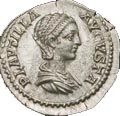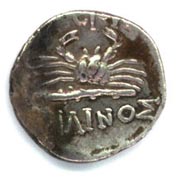Herakles' First Labor - Nemean Lion

The first and most famous of the Twelve Labors, this is also the one whose results are readily visible, as the iconography of Herakles typically includes the skin, often as a head-dress, of the vanquished beast. It is rather curious that the "king of the jungle" - today associated only with sub-Saharan Africa - was chosen as the lead foe of the legendary Mediterranean hero; -More-
Roman Ladies
 From sinners to saints, mistresses to matriarchs - the gallery of Roman Imperial women is both rich and revealing. To be sure, we know much more about the lives of a relative handful of powerful individuals, as opposed to the vast and obscure body of anonymous Romans of both sexes. -More-
From sinners to saints, mistresses to matriarchs - the gallery of Roman Imperial women is both rich and revealing. To be sure, we know much more about the lives of a relative handful of powerful individuals, as opposed to the vast and obscure body of anonymous Romans of both sexes. -More-
Crabs in the Ancient Mediterranean

In addition to dolphins, crabs also figured prominently with the ancients, who identified a star constellation (Cancer) in its shape along the sun's annual sky path, or ecliptic. Of the eventual 88 constellations these 12 had a special significance, being considered the "twelve monthly residences of Apollo", and as signs of the Zodiac were to further propel astrology. -More-
Early Russia
Rich and vast, the Russian coin series spans many centuries, and with a little background,
can prove quite fascinating for more than just the regional specialist.  Its original appearance
dates way back to ca. 1000 AD, when the newly converted Russian state produced some
marvelous issues after the Byzantine model.
Yet, even before the crippling Tatar invasion, monetary issues disappear for almost 350 years,
reemerging in the feudal principalities shaking off foreign yoke. Uninterrupted since to date,
this newer series
can be generally split into two parts: the first period of about 300 years,
dominated by small hammered
coinage ("wire money"), and the second, starting in the early reign of Peter the Great (end of 17th. c.),
with the predominance of more modern milled issues. Our focus here is mainly on the first period.
-More-
Its original appearance
dates way back to ca. 1000 AD, when the newly converted Russian state produced some
marvelous issues after the Byzantine model.
Yet, even before the crippling Tatar invasion, monetary issues disappear for almost 350 years,
reemerging in the feudal principalities shaking off foreign yoke. Uninterrupted since to date,
this newer series
can be generally split into two parts: the first period of about 300 years,
dominated by small hammered
coinage ("wire money"), and the second, starting in the early reign of Peter the Great (end of 17th. c.),
with the predominance of more modern milled issues. Our focus here is mainly on the first period.
-More-

